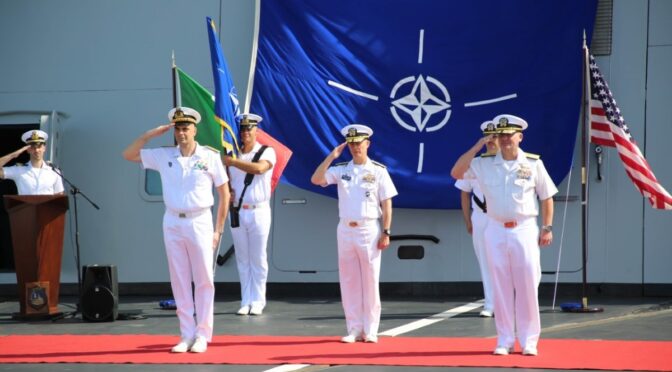Navigating Uncertain Waters: NATO Naval Strategy in a Changing Global Order
As global tensions rise and traditional alliances face unprecedented strain, NATO’s naval strategy stands at a critical crossroads. The collection of recent articles from CIMSEC’s NATO Naval Power Week reveals a complex landscape where shifting American commitments, Russian aggression, Chinese expansion, and European strategic autonomy all converge to challenge the maritime security architecture that has underpinned global stability for decades.
The American Question
Perhaps the most pressing concern for NATO’s naval planners is the uncertainty surrounding American commitment to European security. The provocatively titled “Parting Ways: A NATO Naval Strategy Without America” contemplates a scenario in which NATO must develop a naval strategy independent of U.S. participation. The article argues that “America has become an unreliable ally” and advocates for European nations to “accept full responsibility for their own defense.”
This potential reality necessitates a radical reimagining of NATO’s naval architecture. The article proposes specialized roles for different European navies: France, Italy, and the UK would provide aircraft carriers; France and the UK would maintain strategic ballistic missile submarines; France, Germany, Norway, and the UK would supply attack submarines; and smaller maritime nations would contribute escorts and mine-countermeasures assets.
European Responses: Unity and Division
Europe’s response to this uncertain landscape appears divided between bolstering NATO collaboration and pursuing EU-driven “strategic autonomy.” The Red Sea crisis illustrates this tension, where European navies split their efforts between the U.S.-led Operation Prosperity Guardian and the EU-led Operation Aspides. This division of effort created what one article calls “a divided naval commitment” that undermined effectiveness.
The differing strategic perspectives are stark: “Americans prefer to charge ahead, whereas Europeans tend to build trenches.” This divergence manifests in the Red Sea operations, where U.S. forces took an offensive approach against Houthi positions while European efforts focused on defensive escort missions.
Regional Naval Innovations
Several articles propose innovative solutions to strengthen NATO’s naval posture in specific regions:
- Baltic Integration: The accession of Finland and Sweden to NATO has transformed the Baltic Sea’s strategic landscape. One proposal calls for creating a third Standing NATO Maritime Group (SNMG-3) dedicated to Baltic operations, leveraging new capabilities from Baltic states including Poland, Germany, Denmark, Finland, and Sweden.
- Mediterranean Coordination: An analysis of Spain’s maritime security architecture advocates for establishing a Spanish Coast Guard to enhance coordination on NATO’s southern flank, addressing the “hydra-like maritime constabulary presence” currently divided among multiple agencies.
- Indo-Pacific Engagement: France’s deployment of its carrier strike group to the Indo-Pacific demonstrates how European naval power can still project globally, with operations from the Mediterranean through the Indian Ocean to the Western Pacific, engaging partners from India to Japan.
Keeping America Engaged
Despite concerns about American reliability, several articles propose strategies to maintain U.S. engagement in European maritime security:
- Arctic Collaboration: By monitoring Chinese activities in the Arctic, European navies can align with American security priorities. The “near-Arctic” ambitions of China create common cause between NATO allies concerned about High North security.
- Indo-Pacific Support: European naval deployments to the Indo-Pacific can demonstrate burden-sharing with the U.S. in containing China, potentially increasing American willingness to remain engaged in European security.
- Defense Procurement: Purchasing American naval systems can create industrial and political incentives for continued U.S. involvement in NATO maritime operations.
Strengthening Operational Integration
Regardless of geopolitical uncertainties, NATO must improve its operational effectiveness. Wargaming insights highlight several areas for improvement:
- Command Structure: Streamlining command relationships between U.S. Naval Forces North, Naval Forces Europe, NATO Maritime Command, and Striking Forces NATO would enhance unity of effort.
- Maritime Domain Awareness: Developing a “federated Common Operating Picture” would integrate sensor data from U.S. and NATO forces, improving threat detection and response capabilities.
- Rules of Engagement: Harmonizing authorities and pre-approving crisis response options would allow faster, more cohesive action in emergencies.
- Logistics Resilience: Enhancing coordination between sustainment commands and expanding expeditionary logistics capabilities would improve operational endurance in contested environments.
Conclusion
NATO’s naval forces face a period of profound change and challenge. Whether adapting to potential American disengagement, balancing NATO commitments with EU strategic autonomy, or countering threats from Russia and China, the alliance must evolve to maintain maritime security in an increasingly contested environment.
The path forward requires difficult conversations about burden-sharing, command structure, and strategic priorities. However, NATO’s history suggests that the alliance can adapt to changing circumstances while maintaining its core mission of collective defense. As one article notes, developing effective naval strategy will take time and “there will be missteps along the way.” Yet the stakes—securing Europe against growing threats—demand this effort.
In navigating these uncertain waters, NATO naval strategists would do well to remember that maritime security is not merely about ships and systems but about the political will to utilize them effectively in service of shared values and interests. Only by aligning capabilities with commitment can NATO maintain its maritime edge in the challenging years ahead.
Note: Recently, the Center for International Maritime Security (CIMSEC) published an interesting series of articles on the way ahead for NATO Navies.
This how Dmitry Filipoff, highlighted the purpose of the series:
“NATO finds itself at an inflection point as U.S. commitment to the alliance is in doubt while the war in Ukraine rages on. The maritime dimension of NATO’s security deserves to be extensively reevaluated in light of these circumstances. New strategic and operational considerations can shape the alliance’s naval power as it adapts to the most uncertain threat environment it has faced in decades.”

